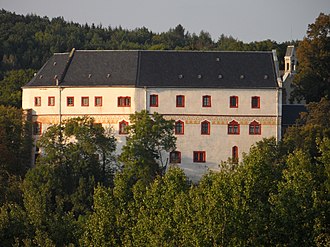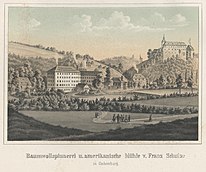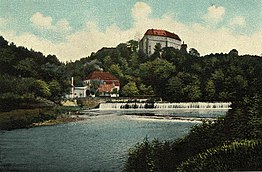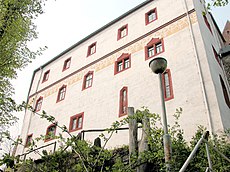Sachsenburg Castle
Sachsenburg Castle rises near Frankenberg / Sa. on a rock over the Zschopau . The castle, which was built in the early 13th century at the latest, was converted into a castle in the 1480s. The complex is one of the few examples of a completely preserved late Gothic residential palace in Saxony.
history
middle Ages
The Lords of Sachsenburg were first mentioned in a document in 1197. It is uncertain whether a castle already existed at that time. Around 1210/30, however, the existence of the castle can be reliably proven on the basis of archaeological finds. The builders were evidently the Lords of Mildenstein . After the smashing of their rule in connection with the Mildenstein tithe dispute by Margrave Heinrich the Illustrious in 1232, the rule passed into the possession of this Wettiner .
Around the middle of the 13th century, rich silver-containing lead and copper ore discoveries were made on the staircase in the Sachsenburg corridor ; the mountain town of Bleiberg was created , which fell into desolation after the middle of the 14th century.
In the time of the mountain blessing , the Sachsenburg served to protect the mining industry. At the end of this first rich mining era in this region (1364), the Wettins sold the castle to two Döbelner knights.
In 1368 the property became the property of the Lords of Schönberg . Caspar von Schönberg († November 1, 1489 or 1491 in Zwickau) had the Sachsenburg in its present form built by the Saxon master builder Hans Reynhart on the remains of the older castle around 1480 (according to dendro ). An inscription in the chapel indicates that the building was completed in 1488 as a Gothic residential palace. The building complex encloses a triangular courtyard.
From 1610 the castle served as an administrative building for the Electoral Saxon Office of Sachsenburg with Frankenberg. However, the small administrative district comprised only ten localities. During the Thirty Years War the first and second outer bailey were destroyed and the castle looted.
19./20. century
After it was given up as the administrative center (1864), a phase of varied uses began. From 1864 the castle was used as custody for young female prisoners and in 1867 a penal and correctional institution was established here. The property was only reserved for prisoners until 1926, although from 1914 there were prisoners of war (Russians, including interned academics and students from the Freiberg Mining Academy , Englishmen, Serbs).
In 1926, the state of Saxony had the Sachsenburg converted into a primary school home. In 1933 there was a brief protective custody camp here , which was later moved to a spinning mill on the Zschopau (see: Sachsenburg concentration camp ). From 1933 it served the NSDAP as a Gauführer School for the Nazi women in Saxony. Towards the end of the Second World War, the castle was then used as a bacteriological institute (branch of the Robert Koch Institute ). (An exhibition was later set up for this period.)
After the end of the war, Sachsenburg served as a residence for resettlers before a youth work center was set up in 1947 , which existed until 1967. From 1968 onwards, the state-owned Dresden housing estate was in control of the castle, which used the castle as a children's holiday camp and training home.
Todays use
In 1990 the Sachsenburg was sold to the Stuttgarter Hofbräu AG for one mark. Restitution claims led in 1993 to the transfer of the castle to the community of Sachsenburg (since 1994 part of Frankenberg). After unsuccessful further attempts to sell the system, the city of Frankenberg and the Kuratorium Schloss Sachsenburg e. V. structurally secured and renovated, with the construction work being accompanied by intensive construction studies under the direction of Wolfgang Schwabenicky . Despite the ongoing construction work, several exhibitions (castle history, excavations and medieval mining on the stairwell, pictures by the Hainichen artist Leo Lessig) were on view at the castle .
In December 2015, Saxony's Minister of the Interior, Markus Ulbig, presented the city of Frankenberg with a funding decision of seven million euros. As a reason, he stated that “Sachsenburg Castle is one of the most important cultural-historical and structural castle ensembles in the Free State of Saxony. The building is a defining example of a completely preserved residential palace. ”After the renovation, the plan is to use the palace as a museum as well as an education and congress center with restaurants and hotels. The money comes partly from the federal-state program “Urban Protection of Monuments” (4.75 million euros), and partly from funds from the Free State of Saxony (almost 2.4 million euros). The Sachsenburg is currently under renovation (2019).
literature
- Hendrik Bärnighausen (Red.), State Palaces, Castles and Gardens of Saxony (Ed.): Palace construction of the late Gothic in Central Germany . Conference proceedings. Sandsteinverlag, Dresden 2007, ISBN 978-3-940319-23-4
- Alfons servant von Schönberg : Sachsenburg. Dresden 1931. (Reprint from: Communications of the Landesverein Sächsischer Heimatschutz. Volume XX, Issue 9–12.)
- Wolfgang Schwabenicky: Sachsenburg Castle near Frankenberg and its predecessor - results of building research 2002-2004. In: Wartburg Society for Research into Castles and Palaces, Germanisches Nationalmuseum (Hrsg.): New research on early castle construction. Deutscher Kunstverlag, Berlin, Munich 2008, ISBN 978-3-422-06569-7 , pp. 243-258
- Richard Steche : Sachsenburg (castle). In: Descriptive representation of the older architectural and art monuments of the Kingdom of Saxony. 6th booklet: Amtshauptmannschaft Flöha . CC Meinhold, Dresden 1886, p. 82.
Web links
Individual evidence
- ↑ vonschoenberg.org The year of death of Caspar Von Schonberg is not known, he probably died in 1491, because in the feudal letter of January 7th, 1492 he is described as deceased and his tenure is handed over to his three sons.
- ^ Sachsenburg Castle
- ↑ Millions for the renovation of Sachsenburg Castle . In: Saxon newspaper . December 21, 2015 ( online [accessed November 23, 2018]).
Coordinates: 50 ° 55 '58.1 " N , 13 ° 1' 46.9" E










